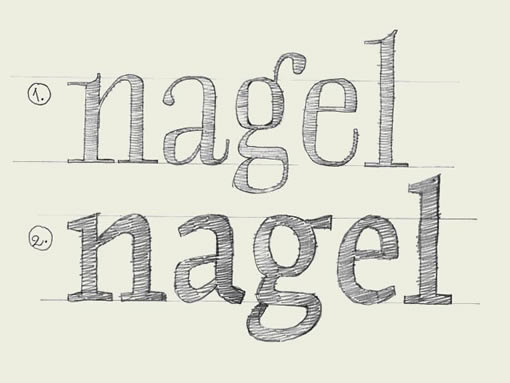|

点击放大
Readability. The only important aspect of a text typeface is the readability. Many decisions can influence the readability. Which contrast you create, the length of the ascenders and descenders, the rhythm, the blackness of a type, the strength of the curves and the bowls, etc.
可读性是正文字体的唯一考量指标。你对字体所做的许多决定都会影响可读性。例如采用怎样的粗细对比,上伸部和下伸部的长度,字体的节奏,黑度,曲线和字碗的力度,等等。
Most of those decision apply to all the characters inside a font. These have to be defined first. For example the contrast. The characters on the top line (see drawing) have a much bigger contrast than the characters on the bottom line. The type on the top line will be more suitable for display use, the type the bottom the bottom line more for text use. Not only because of the difference in contrast, but also because the characters on the top line are much more condensed. This makes them less legible in small sizes, but more eye-catching and flexible for headlines. Defining the contrast and the width are decisions which count for every single character in a font.
大部分的决定会影响到字体中的全部字符。下面这些是应该首先考虑的。比如说粗细对比。图例中上面一行的字符笔画粗细对比明显要比下面一行的要大得多。上一行的字体更适合做特排字体,而下一行更适合做正文字体。不仅仅是因为它们粗细对比的差异,还由于上一行的字符的字宽更小,因而在小尺寸下更难以识别——但是却更能吸引眼球,在制作标题的时候也更具灵活性。所以在定义字体的粗细对比和宽度的时候,要考虑到字体中的全部字符。
But also while designing every single glyph, you can create details which improve the readability of a font. For example, the ear of a 'g' can make sure the reader's eye will follow the horizontal reading direction more fluently. The 'g' on the bottom line will work much better in a text typeface for small sizes (see drawing).
不过,在设计每一个具体字符的时候,你可以通过增加一些细节来提升该字体的可读性。举例来说,小写字母g右上角的字耳会有助于阅读者的视线更平滑的水平移动。如果用作正文字体,图中下面一行中的"g"在小尺寸下的表现会相当不错。
英文原文
本文链接:http://www.blueidea.com/design/doc/2007/5151.asp 
出处:蓝色理想
责任编辑:tada
|







